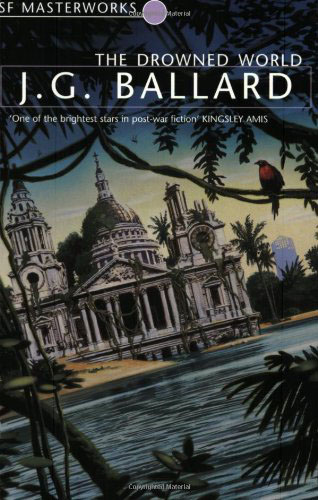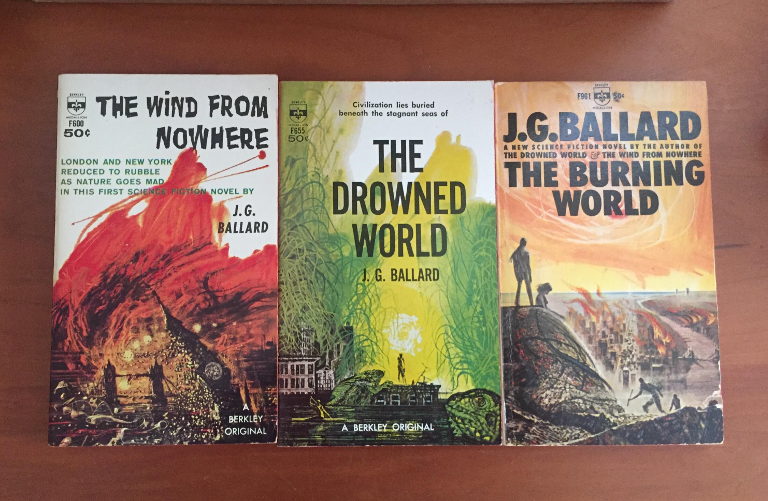 The Drowned World: A Novel (50th anniversary edition)
The Drowned World: A Novel (50th anniversary edition)
By J. G. Ballard; introduction by Martin Amis
208 pp. Liveright Publishing Corporation, July 2012.
Hardcover, $23.95; paperback, $15.95.
Sixty years ago this year, the late great British science fiction author J. G. Ballard published his novel The Drowned World. The book is a disaster novel, one that has come to be regarded as a seminal contribution to the climate fiction genre. It’s remarkable for its vivid depiction of a possible future Earth, its fascinating exploration into the psychological effects of environmental change and its brilliant inversion of the standard disaster story formula.
The novel finds Earth in the midst of runaway climate change caused not by humans, but by a prolonged period of solar storm activity. In its climate, geography and life forms, this new Earth is a chaotic mashup of elements from various points along its prehistoric hothouse past (mostly from the Carboniferous and Triassic periods, which are repeatedly invoked). The majority of the planet is too hot for humans, but plants and reptiles are flourishing explosively, ferns growing as tall as sequoias and giant lizards presiding over former corporate boardrooms among the inundated ruins. Malaria—spread by mosquitoes as big as today’s dragonflies—is now common well beyond the equator. The continents have been completely reshaped by the rising seas and the shifting of billions of tons of topsoil. The continental interiors are covered in lagoons, jungles and silt flats.
Humans and other mammals occupy an ever-dwindling ecological niche. Mammalian fertility in general has been steadily waning, and human births have become comparatively rare. The total human population has gone from billions of people dominating most of the planet to a mere several million concentrated around the now-subtropical poles. In a moment of dark whimsy, one character wonders with amusement whether “a point might ultimately be reached where a second Adam and Eve [find] themselves alone in a new Eden.”
A United Nations military unit has been traveling the globe for the past three years, surveying what’s left of the world’s former capitals. At each new stop, the team, led by gruff military man Colonel Riggs, sets about mapping the coastline, studying the wildlife and evacuating any remaining inhabitants (who are generally either in terrible health or psychopathic). The biological studies are carried out by the main hero of our story, Robert Kerans, and his assistant, Alan Bodkin. The team is currently stationed amid the partially submerged remnants of London. Once its work there is done, it will leave the city to its fate and move on to another forsaken former capital, where the process will be repeated.
Kerans and Bodkin are fatalistic about the world taking shape around them, repeatedly commenting on how its flora and fauna are evolving exactly as scientists predicted decades ago, so there’s scarcely any point in continuing to study them. Indeed, Kerans has come to regard the reports he sends to his superiors at Camp Byrd, in northern Greenland, as a “pointless game,” doubting that anyone still bothers to file or even read them. There’s a sense that humanity has resigned itself to the will of nature—a feeling heightened by the way the mutated horsetails and club mosses physically dwarf our characters like corn stalks towering over a mouse, and the way the lizards watch and judge the humans’ every move like sentries standing guard.
As the story opens, the team’s stay in London has been cut short. Riggs has received orders from Camp Byrd to pack up and return to the camp immediately. It seems the waters are continuing to rise, rendering worthless all the effort spent on coastal mapping. In addition, the London region is about to be hit by soaring temperatures as well as monsoon conditions brought on by the northern-migrating equatorial rain belts, which likely will make the waterways leading into and out of London impassable in the coming months due to the ever-accumulating silt. The upshot of all this is that the area will soon be unfit for human survival, and there may be no way of rescuing anyone left behind.
If this were a conventional disaster story, it would have our heroes frantically racing against time to either escape from, or somehow put an end to, the situation just described. Instead, our three main protagonists—Bodkin, Kerans and Kerans’ lover Beatrice—find themselves intractably drawn to the coming disaster, and stay behind to welcome it when everyone else flees northward. How they cope psychologically with their devolving environment then becomes the novel’s focus.
The scientific explanation as to why these three are compelled to stay behind unfortunately goes quite a bit beyond the threshold of believability. It includes a lot of really abstruse psychoanalytic terminology and a long-discredited (even at the time this novel was written) theory called organic memory, which held that all organic matter has memory. “Every step we’ve taken in our evolution is a milestone inscribed with organic memories,” explains Bodkin. It seems these memories are now expressing themselves in the form of troubling dreams that are driving the characters to surrender themselves to the newly resurgent ancient ecosystem. The world is essentially traveling back in time, and humans are alone among nature’s creatures in trying to resist this backward tide. Despite the shakiness of the science behind all this, there’s no denying the sheer hypnotic surreality with which it’s rendered. Ballard ingeniously succeeds in getting us inside the characters’ heads as they succumb to the call of their organic memories.
The Drowned World isn’t a plot-driven tale; rather, it’s a contemplative, richly atmospheric study of a place and a set of characters. The lack of narrative drive is due to the metabolic slowdown the characters seem to undergo as they psychologically metamorphose, along with the increasingly brutal heat that oppresses them whenever they go outside. Amidst this heat and the ever-worsening weather, they languidly pass the weeks. Kerans, in his mold-ridden penthouse suite in what was once the Ritz, ponders the nature of time and the shifting landscape of his psyche. Beatrice drinks alone in her apartment along the shore of a neighboring lagoon. Bodkin wistfully wanders around the flooded husks of old haunts (“Not that they contained anything other than his memories,” laments the narrator). These routines are interrupted at irregular intervals by increasingly jarring recurrences of the dreams, or the journeys “through archaeopsychic time,” as Kerans comes to think of them.
About halfway into the book, we’re introduced to an antihero named Strangman. He’s the leader of a pirate crew that comes to the London lagoons looking for loot. With his white suit and entourage of tamed alligators, he’s nothing if not a showman. He and his gang are reminiscent of Mr. Kurtz and his followers in Joseph Conrad’s Heart of Darkness, except that they’re after salvage rather than ivory. Like Kurtz, Strangman undergoes a descent into savagery and insanity, becoming ever more threatening as he insinuates himself into the lives of our protagonists.
Though they eventually become arch foes, there’s some fascinating philosophical discussion early on between Strangman and Kerans. Their conversations give us a revealing glimpse into the two men’s clashing perspectives on the past: the biologist’s affinity to deep time versus the treasure hunter’s love for the transitory details that get lost over such vast temporal swaths.
There is no sense of hope for humanity at the end of this novel. Most of the planet’s human habitat has vanished, and it’s surely only a matter of time before even the poles become too hot. But so great is the mesmeric power of this book’s spell that it manages to make the specter of human extinction seem like a paradisiacal retirement (again invoking Eden). Even so, let’s hope that such a scenario is still far off in our real-world future.






